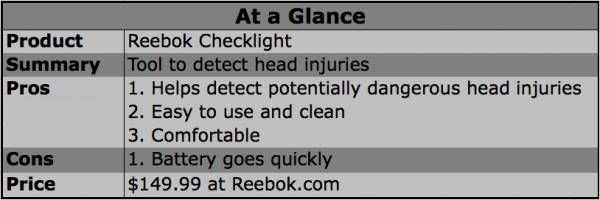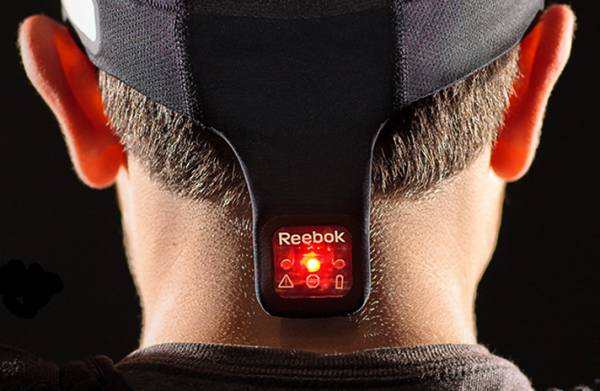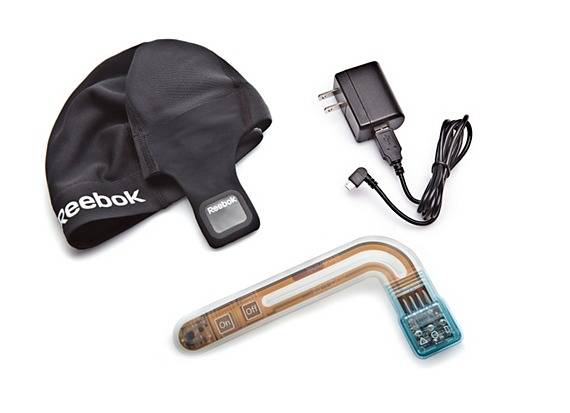
Since controversies of head trauma and concussion have hit the forefront in contact sports, companies like Reebok have begun designing products to increase head trauma awareness. Hospitals, doctors, and exercise physiologists all agree that parents, coaches, and players need to become more conscious about brain health. All too often, kids and adults experience a collision that could impair them in the long term. The problem is, these individuals unknowingly put themselves at risk by returning to the game too soon through a lack of education or failure to utilize technology.
The Reebok Checklight, named CES 2014 Best of Innovations, provides athletes with an inside track aimed at predictive impact measures. Ultimately, the device can’t diagnose impacts that result in concussion or similar brain injuries, but it does serve as a means for interaction and intervention.
I recently had an in-depth conversation with Mr. Dan Sarro of Reebok Sports, and we discussed the importance of brain impact studies. Unfortunately, no product is the end all, be all preventative measure that we want. What the Reebok Checklight does is provide parents with peace of mind. According to Reebok, the Checklight provides, “Consistent, reliable, actionable impact data.” What does that mean?
Essentially, the Checklight is not a concussion predictor or preventer. Every athlete is different. Some can sustain more severe blows with little to no occurrence of symptoms, while others aren’t so lucky. Concussion produces a magnitude of symptoms from nausea, to headache, to blurry vision, but further testing is still required to properly diagnose a concussion. Headaches can produce similar symptoms, but not be concussion-related. A sensor built into the Checklight uses specific algorithms to measure G-forces (forces acted upon the body as a result of gravity). By measuring these forces, the Checklight gives you three clear understandable criteria for impact severity.
The three lights on the back of the Checklight are your gauges. When an impact occurs, immediately the Checklight provides feedback. A green light means a less severe hit, a yellow light indicates moderate, and a red light warns of a more severe impact. No light being illuminated indicates no questionable impacts have occurred. Again, these lights are not a concussion predictor, but they do give parents and coaching staff reasons to check the impact data of their players and children to ensure safety. Any player who sustains a hit that registers a yellow or red light should be examined by a trainer or doctor to ensure that returning to play is safe.

I’ve been wearing the Checklight while playing hockey for a little over a month now. Fortunately, I haven’t sustained any red lights. In fact, I haven’t had any yellow lights either, so I guess you can say I’ve been fortunate. If I had noticed my Checklight indicator was lit, I wouldn’t have hesitated to get it checked out. While the game of hockey is highly competitive, there is no reason to risk your life for it. Wearing a Checklight ensures that you consciously take responsibility for your safety. Gone are the days when a player can pretend to shake off a considerable hit. The Checklight provides players and coaches with a sense of accountability.
As for fit, I have a pretty large head, so I required an extra large. Using the chart on Reebok’s website provides you with accurate sizing. The skullcap should fit snugly on the head, but comfortably under your helmet. I will suggest that you use a Reebok helmet, as well. I tested it with a Bauer 4500 and it was doable, but the Reebok 11k provided more comfort.
Turning the Checklight on and off is a breeze, so even young children can handle it on their own. The sensor is fully removable, allowing you to wash the skullcap. Just plug the sensor into a USB charger and you’ll have battery life for hours. One thing to note: if you don’t use the Checklight daily, then make sure you keep it charged. It does have a tendency to drain the battery when not in use.

Another key feature of this device is impact logging. Every time you turn the Checklight on, you will be provided with a set of flashes that indicate the number of impacts in each zone. With accountability being so important, parents and coaches can check for lights immediately following every practice or game. It eliminates the guesswork around the dangers of contact sports.
If you’re a parent who checks for a red or yellow light following practice, you can use the information to actively engage your child. Be proactive about your child’s brain health and ask questions about how practice went. In addition, with the Checklight, coaches become the first line of defense. A blinking light is easily noticeable and a clear indicator that the player in question should be pulled aside and examined.
So far I’m pleased with the feedback the Checklight has provided me. Comfort, ease of use, and accuracy are key features required in sports, and the Checklight delivers in all these areas. Likewise, Reebok is proud to provide athletes with an opportunity to increase awareness. During my conversation with Dan Sarro, he was adamant that the real goal for Reebok is to open the minds of consumers, increase awareness that concussions and brain injuries should be taken seriously, and provide a product that will aid in prevention. As a player and coach, I think Reebok has definitely accomplished something here.
Reebok Checklight is available for $149.98 at Reebok.com.






